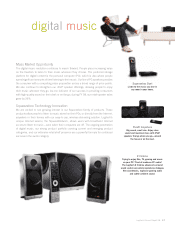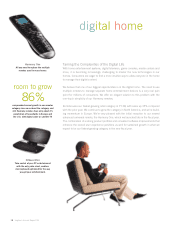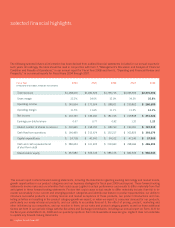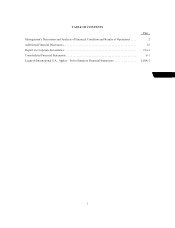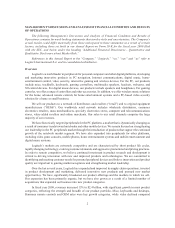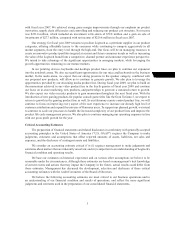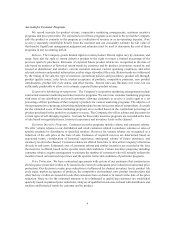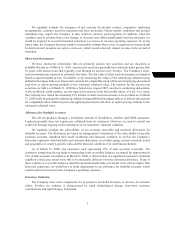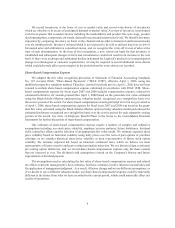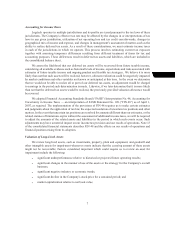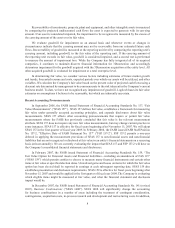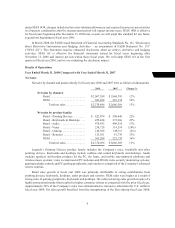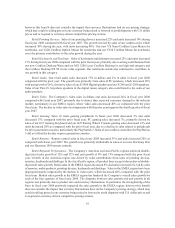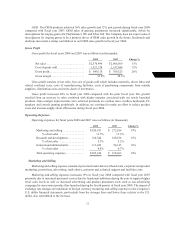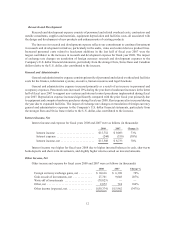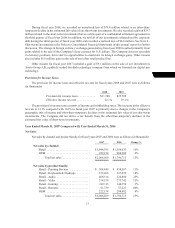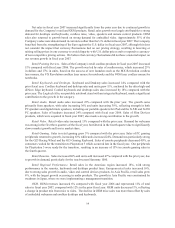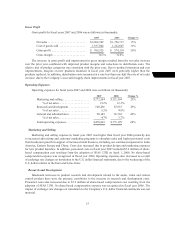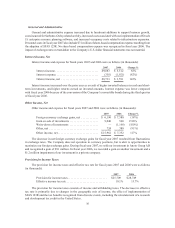Logitech 2008 Annual Report Download - page 28
Download and view the complete annual report
Please find page 28 of the 2008 Logitech annual report below. You can navigate through the pages in the report by either clicking on the pages listed below, or by using the keyword search tool below to find specific information within the annual report.6
We record inventories at the lower of cost or market value and record write-downs of inventories
which are obsolete or in excess of anticipated demand or market value. A review of inventory is performed
each fiscal quarter that considers factors including the marketability and product life cycle stage, product
development plans, component cost trends, demand forecasts and current sales levels. We identify inventory
exposures by comparing inventory on hand, in the channel and on order to historical and forecasted sales
over six month periods. Inventory on hand which is not expected to be sold or utilized based on review of
forecasted sales and utilization is considered excess, and we recognize the write-off in cost of sales at the
time of such determination. At the time of loss recognition, a new, lower-cost basis for that inventory is
established and subsequent changes in facts and circumstances would not result in an increase in the cost
basis. If there were an abrupt and substantial decline in demand for Logitech’s products or an unanticipated
change in technological or customer requirements, we may be required to record additional write-downs
which could adversely affect gross margins in the period when the write-downs are recorded.
Share-Based Compensation Expense
We adopted the fair value recognition provisions of Statement of Financial Accounting Standards
No. 123 (revised 2004), “Share-Based Payments” (“SFAS 123R”), effective April 1, 2006, using the
modified prospective transition method. Therefore, results for periods prior to April 1, 2006 have not been
restated to include share-based compensation expense calculated in accordance with SFAS 123R. Share-
based compensation expense for fiscal years 2007 and 2008 includes compensation expense, reduced for
estimated forfeitures, for awards granted after April 1, 2006 based on the grant-date fair value estimated
using the Black-Scholes-Merton option-pricing valuation model, recognized on a straight-line basis over
the service period of the award. For share-based compensation awards granted prior to but not yet vested as
of April 1, 2006, share-based compensation expense for fiscal years 2007 and 2008 was based on the grant-
date fair value estimated using the Black-Scholes-Merton option-pricing valuation model and reduced for
estimated forfeitures recognized on a straight-line basis over the service period for each separately vesting
portion of the award. See Note 12-Employee Benefit Plans in the Notes to the Consolidated Financial
Statements for further discussion of share-based compensation.
Our estimates of share-based compensation expense require a number of complex and subjective
assumptions including our stock price volatility, employee exercise patterns, future forfeitures, dividend
yield, related tax effects and the selection of an appropriate fair value model. We estimate expected share
price volatility based on historical volatility using daily prices over the term of past options or purchase
offerings, as we consider historical share price volatility as most representative of future stock option
volatility. We estimate expected life based on historical settlement rates, which we believe are most
representative of future exercise and post-vesting termination behaviors. We use historical data to estimate
pre-vesting option forfeitures, and we record share-based compensation expense only for those awards
that are expected to vest. The dividend yield assumption is based on the Company’s history and future
expectations of dividend payouts.
The assumptions used in calculating the fair value of share-based compensation expense and related
tax effects represent management’s best estimates, but these estimates involve inherent uncertainties and
the application of management judgment. As a result, if factors change and we use different assumptions, or
if we decide to use a different valuation model, our share-based compensation expense could be materially
different in the future from what we have recorded in the current period, which could materially affect our
results of operations.



